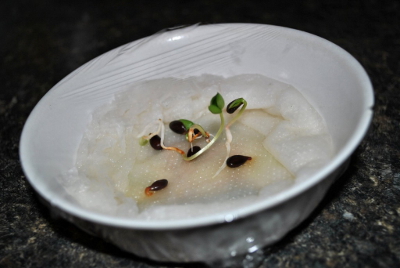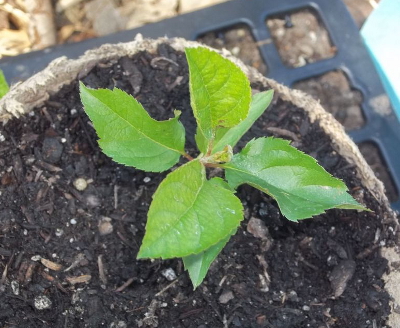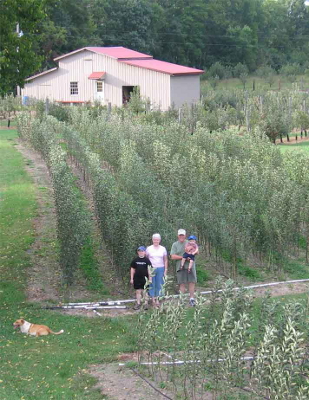
Why and how to grow apples from seed
 Ever since I read the apple chapter in The Botany of Desire,
I've wanted to plant some apple seeds and see if my toss of the dice
turns up a new variety worth keeping. What held me back then was
that I didn't have any land to plant on. And after we got our farm,
I figured I'd have to set aside an absurd amount of space for the
experiment since each tree would be a standard apple, meaning they'd
need to be planted at least 30 feet apart.
Ever since I read the apple chapter in The Botany of Desire,
I've wanted to plant some apple seeds and see if my toss of the dice
turns up a new variety worth keeping. What held me back then was
that I didn't have any land to plant on. And after we got our farm,
I figured I'd have to set aside an absurd amount of space for the
experiment since each tree would be a standard apple, meaning they'd
need to be planted at least 30 feet apart.
But then I started playing with high-density methods,
and learned that judicious pruning and training can make even large
trees small. So I started pondering --- could I plant seeds three
feet apart as if I were making a high-density apple planting, then use
that test orchard to try out seedling genetics? Presumably, it
might still be five or more years before I'd get a taste of these
experimental trees, but that still gives me time for many apple
generations in my lifetime. And if any of the seedling apples are
worth experimenting with further, I can either transplant the tree or
graft its scionwood onto a smaller rootstock. Worst case scenario,
I get a lot of firewood out of the deal.
 The
pros tend to plant somewhere between 10,000 and 50,000 seeds to get one
variety worth keeping, and I'd definitely plant many, many fewer.
But it's more fun that going to Vegas --- my kind of gambling.
Want to play?
The
pros tend to plant somewhere between 10,000 and 50,000 seeds to get one
variety worth keeping, and I'd definitely plant many, many fewer.
But it's more fun that going to Vegas --- my kind of gambling.
Want to play?
I'm looking for some
interesting seeds to start my planting, and I promise to name the new
variety after you if you're the source of the seeds. Drop me an email
if you're interested with the name of the mother variety and the
possible fathers (other apple trees close to your tree). I'm
less interested in store-bought apples because the father in that case
is often a crabapple, included in the planting to fertilize the named
varieties, and I'm most interested in off-spring of these disease-resistant apple varieties.
Or you can play along at
home! Here's what I plan to do --- put each batch of cleaned apple
seeds in a labeled ziplock bag surrounded by a damp rag (or paper towel
if you roll that way). Apple seeds need at least a month of cold stratification, so the bag will go in the  fridge,
and I'll start checking on it weekly after the month is up. Once I
start to see sprouts, I'll transfer the seeds to a pot, and then,
eventually, to a nursery row.
Alternatively, you can get the same stratification effect by planting
your seeds directly in the ground right now, allowing them to go through
a normal winter. Either way, expect only about 30% germination,
so plant lots of seeds.
fridge,
and I'll start checking on it weekly after the month is up. Once I
start to see sprouts, I'll transfer the seeds to a pot, and then,
eventually, to a nursery row.
Alternatively, you can get the same stratification effect by planting
your seeds directly in the ground right now, allowing them to go through
a normal winter. Either way, expect only about 30% germination,
so plant lots of seeds.
As a final side note, if
you've got the space for standard trees, you might plant seeds for
another reason --- to serve as rootstocks to be grafted onto. Many
people will plant a dozen or more seeds where they want the eventual
tree to grow, then will weed out all but the most vigorous specimen a
year later. After grafting, these experimenters get a tree with no
transplant shock. Although I've never heard anyone else say this,
it seems to me you could also get at least a little bit of dwarfing
action from seedling rootstocks if you choose seeds from less vigorous
varieties (like crabapples, self-pollinated Cox's Orange Pippin, Lady, and spur-type Winter Banana and York), or if you choose the least
vigorous seedling when it comes time to weed out your planting.
I'd be very curious to hear from anyone who's used seedlings as
rootstocks --- how did your trees turn out?
(As a final note, these photos aren't mine --- as usual, click to see the source.)
Want more in-depth information? Browse through our books.
Or explore more posts by date or by subject.
About us: Anna Hess and Mark Hamilton spent over a decade living self-sufficiently in the mountains of Virginia before moving north to start over from scratch in the foothills of Ohio. They've experimented with permaculture, no-till gardening, trailersteading, home-based microbusinesses and much more, writing about their adventures in both blogs and books.
Want to be notified when new comments are posted on this page? Click on the RSS button after you add a comment to subscribe to the comment feed, or simply check the box beside "email replies to me" while writing your comment.

I've rethought my entire strategy regarding fruit and nuts last summer/early fall. We have a young orchard in Oregon which is supposedly deer fenced and is about an acre is size. We've added raspberries, more gooseberries, a couple of olives and almond trees along with a few other goodies. I had persimmons and apples, in particular, on the list along with chestnuts and walnuts for the coming nursery splurge. But sometime in August, the deer and elk made it into the orchard and ate every single green leaf in sight (except for the four figs.) We've regrouped and are now using a myriad of fence posts sourced from the surrounding landscape to start to put up protection around each tree. A neighboring cattle pasture has cherry, plum, various nuts, figs, and full-size pear and apple trees (mostly apples) which are decades old and open to wildlife and cattle browsing. Taking a cue from that, I've determined that I will keep my berries and any trees which need special bear protection in the orchard (bears will climb peach and nectarine trees, for example, and the trees can't handle their weight.) But I'm hoping to get standard size fruit and nut trees and plant a wildlife/human orchard on a separate hilltop. I'm guessing they will need individualized protection for the first 5 years, but then after that just plan on having everything within browse level being pruned by wildlife. Will take longer to mature, but I will take less time on pruning/shaping, and just focus on protecting the bark and growth tips in the near-term. Might make a good place to hunt in the future as well. I just have to plant more because it won't be protected, which means I have to have enough to 'share.' Maybe I can use this method to grow my own standard sized apple root stock and then graft from my favorite of the apples in the neighbors' pastures as well as names varieties that I'm really keen to try.
Hi Anna and Mark,
Nice. Just what I have been trying to figure out! How to start apple trees.
I've got a couple apple trees and a pear starting to grow. I think starting a bunch is probably the best way to get something that works and produces fruit by itself?
I have been throwing apples here and there but have yet to see any starts from that effort?
If a bunch were started here and there, the few stronger ones will survive and probably continue to produce and grow for a long time?
Bill Mollison talks about apple trees starting naturally in berry bushes. Maybe this solves the being eaten problem? If you plant them among your HUGE berry bushes, starting them and keeping them from being eaten would be automatic?
warm regards to you both, John
You take your seed, plant it, hack a stick off later in the year, then graft her to your mature Bud9 tree... Most will flower and fruit within 2 years. Some even the next year!
Though; Fl does have an odd effect on fruit trees from outta state.
It might be that the high stress plays a role in causing trees to fruit so readily.
Most will flower and fruit within 2 years. Some even the next year!
Though; Fl does have an odd effect on fruit trees from outta state.
It might be that the high stress plays a role in causing trees to fruit so readily.
In 2002 I planted seeds from a couple of apples from the store. I don't remember what they were, but they were really good and somewhat unusual. At the time I did not know that apple don't grow true to their parent. I thought I could grow an apple of that variety by planting its seed.
I got three trees out of that effort. When they were about 2 years old, they were heavily browsed by deer. One of them never really recovered from that, so I ripped it out. Another recovered very slowly, but was fairly stunted and diseased, until 3 years ago when it seemed to develop super strength and now looks like it will become a healthy tree. It is about 7 feet tall. The third seedling was super healthy and really took off (it is 25 feet tall). It has been producing attractive and tasty apples for about 5 years. I decided to name it "Miss Jessamine" after my daughter Jessamine (pronounced jess-a-min). Here is more info & photos: http://www.homeorchardsociety.org/forums/viewtopic.php?t=5392
I could send you some Miss Jessamine seeds if you'd like. However I do have a crabapple tree in my yard so there is a chance the seeds have a crabapple father. But I also have two other apples (Golden Delicious & ???), and my neighbors have apples.
Everyone --- Fascinating to hear about your experiments!
Dave --- I'd love to try some of your second-generation experiment! What would you say Miss Jessamine tastes the most like?
You can mail the seeds to: Anna Hess P.O. Box 733 St. Paul, VA 24283
Thank you!
I cannot speak "apple flavor" but I would say it more sweet than tart. The flesh is a bit more firm than most apples, and the skin is a bit more thick than most. I get way fewer codling moths on this tree, I suspect that the thicker skin and/or firmer flesh may explain why. They ripen mid-late October, and they keep well until March.
I am pretty sure that the parent was mostly yellow, but it was not Golden Delicious. I am really kicking myself for not writing it down. I have looked online to see if anything seems familiar but I have always come up empty handed.
I forgot to say that I will send you some seeds next time I pull one out of storage.
Would you like some scions too? That way you'll have a branch/tree that should be good. With the seeds, who knows what you'll get.
Since your post, I've been doing more web research on use of seedlings as rootstock. Raintree Nursery uses Antonovka rootstock for their standard size apple trees. From what I've read online, it seems like Antonovka seeds generally have 90% rate of producing a reliable Antonovka seedling (unlike most seeds.) There seems to be a couple of places offering Antonovka seeds, but these places also are offering seeds from a few other varieties, though they do give the caveat that they won't grow true to variety - but it makes me suspicious.
I'm curious if you have looked into Antonovka seedlings are rootstock and have found other reasons why it might make more sense to focus on this one variety, like at least one mainstream respected nursery does versus using seedlings from saved seeds.